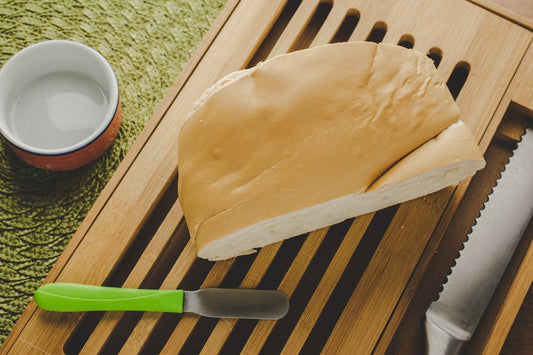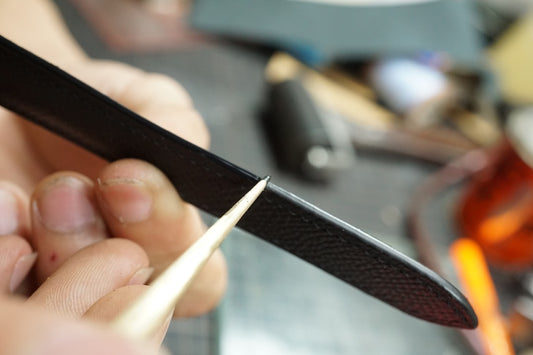
Share
Understanding the Hamon Line on Japanese Blades: A Deep Dive into Blade Finishes and Treatments
Estimated Reading Time: 14 minutes
Key Takeaways
- The Hamon line on Japanese blades is a result of traditional differential heat treatment, marking the boundary between the hard edge and softer spine of the blade.
- Blade heat treatment in Japan combines ancient techniques with precise temperature control to create blades that are both sharp and durable.
- The Tsuchime finish, a hand-hammered pattern, adds both aesthetic appeal and functional benefits, such as reducing food sticking to the blade.
- Hand-hammered knives offer superior craftsmanship, uniqueness, and enhanced performance compared to mass-produced knives.
Table of Contents
- The Hamon Line on Japanese Blades: Signature Blade Finishes and Patterns
- Blade Heat Treatment in Japan: The Foundation of Durability and Sharpness
- Tsuchime Finish Meaning: The Beauty and Function of Hand-Hammered Patterns
- Advantages of Hand-Hammered Knives: Craftsmanship, Utility, and Uniqueness
- Conclusion: The Lasting Value of the Hamon Line, Tsuchime Finish, and Japanese Hand Craftsmanship
- Call to Action: Share and Explore the World of Japanese Blades
The Hamon Line on Japanese Blades: Signature Blade Finishes and Patterns
What Is the Hamon Line?
The Hamon line on Japanese blades is the cloudy or milky pattern running along the blade edge. It marks where the steel has been hardened in a special way, using ancient methods developed over centuries. This visible line, or temper line, usually appears whitish and shimmery. It signifies the boundary between the super-hard edge and the softer, flexible spine of the sword or knife.
- It is a hallmark of Japanese sword and knife making.
- Created by a process known as differential heat treatment or clay tempering.
- Every Hamon line is unique to the blade and smith; no two are exactly alike.
Historically, the Hamon line was not just about looks. It was originally a necessary byproduct of making swords both hard and durable. Today, it’s prized as a mark of authenticity and artistry.
You can see this in detail in resources like The Evolution of Hamon in Japanese Swordmaking, Learn More About This Fascinating Pattern on the Katana Blade, and What is Hamon?.
Frequently Asked Questions
What is the purpose of the Hamon line on Japanese blades?
The Hamon line indicates where the blade has been hardened through differential heat treatment, creating a hard edge for sharpness and a softer spine for flexibility. It serves both functional and aesthetic purposes.
How is the Tsuchime finish applied to a blade?
The Tsuchime finish is created by hand-hammering the blade's surface, resulting in a unique dimpled texture that enhances both the blade's appearance and functionality by reducing food sticking.
What are the benefits of hand-hammered knives?
Hand-hammered knives offer superior craftsmanship, unique aesthetics, better edge retention, reduced food sticking, and enhanced durability compared to mass-produced knives.
Conclusion: The Lasting Value of the Hamon Line, Tsuchime Finish, and Japanese Hand Craftsmanship
Japanese blades are not just tools. They are a blend of art, science, tradition, and innovation. The Hamon line on Japanese blades reveals a history of excellence and ingenuity, embedded in every curve and line.
Key Points:
- The Hamon line marks both artistry and meticulous differential heat treatment, standing as a signature of performance and authenticity.
- The blade heat treatment in Japan is a blend of temperature control, careful timing, and generational wisdom, producing blades with unmatched sharpness and resilience.
- The Tsuchime finish is both visually striking and deeply useful, combining beauty with everyday practicality.
- The advantages of hand-hammered knives set them apart from mass-produced alternatives, promising not only better performance but also a unique feel in every cut.
Japanese blades are revered worldwide because of these unique features and the masterful blade finishes and patterns that come from generations of craftsmanship.
By appreciating these traits, collectors, chefs, and enthusiasts can better understand why Japanese blades occupy a special place in the world of knives and swords.
For more on the history and craftsmanship behind these blades, explore Japanese Knife Craftsmanship History: From Ancient Swordsmithing to Modern Culinary Artistry.
Call to Action: Share and Explore the World of Japanese Blades
Are you passionate about Japanese blades? Do you have a favorite Hamon line pattern, or have you tried cooking with a hand-hammered Tsuchime knife? Share your experiences and thoughts in the comments below!
Want to learn more about Japanese craftsmanship, knife-making techniques, and the cultural history of Japanese blades? Explore resources dedicated to:
- The centuries-old techniques of Japanese smiths
- The evolution of blade finishes and patterns
- Stories behind the world’s most famous swords and knives
Let the artistry and history of Japanese blades inspire your next culinary or collecting journey!


